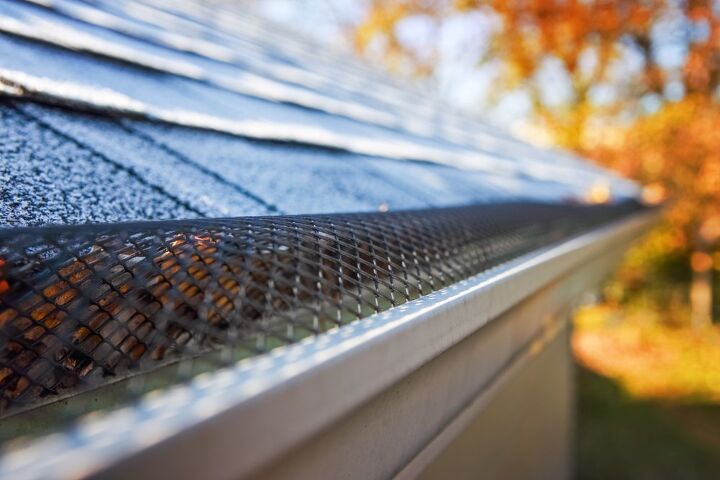Do Gutter Guards Attach Under Shingles?

Gutter guards are a sought-after solution to clogged gutters that are a no-brainer for most homeowners. It is tempting to go out and install gutter guards right away to experience the benefits, but there are many variables. So, do gutter guards attach under shingles?
You can attach gutter guards under shingles but it is dangerous and can cause expensive water damage. A gutter guard can damage the water barrier on your roof which can allow water to enter your home. The best option is to purchase gutter guards that slide over the gutter and screw into place because they are more secure.
Attaching gutter guards under shingles can even void your roof warranty in some cases depending on the provider. Gutter guards are only useful when you install them properly, so it’s worth the extra cost to hire a professional. Follow along as we explore the key factors that affect whether or not you should attach gutter guards under shingles.
Do Gutter Screens Go Under Shingles?
Some gutter guards or screens go under shingles, but it varies based on the brand. Guards that go underneath shingles only need to go under the first row. Check before you buy gutter guards because it isn’t ideal to attach gutter guards under shingles.
Gutter guards that go under shingles can make your roof even more susceptible to water damage. A roof typically features a water barrier that protects the inside of your home from water. There is no way to attach gutter guards under shingles without damaging the barrier.
Any amount of damage to your roof’s water barrier membrane can put your home at risk. Water damage can cause thousands of dollars in repairs and even damage your foundation.
How are Gutter Guards Attached?
Gutter guards are generally attached with screws and the installation is easy. You can slide gutter guards over a gutter without any effort in most cases as long as it fits well. Gutter guards vary from brand to brand, but they often come with screws and or rivets to secure them in place.
Simply attach the screws or rivets at the allotted points on your gutter guards to attach them. It is important to secure gutter guards with screws, rivets, or nails to get the best performance. Otherwise, debris and leaves could easily get into your gutter which would render the guard useless.
Some gutter guards don’t require nails or screws at all which saves time on installation. Always secure gutter guards with nails and screws if the manufacturer suggests it, however. Otherwise, the gutter guards could potentially blow away with the wind.
Can Gutter Guards Cause Leaks?
A gutter guard can cause leaks if you fail to maintain or install it correctly. You must clean your gutter guards regularly or your gutters could get clogged and damaged. Manufacturers and professionals recommend that you clean your gutters at least every 2 years if you have gutter guards.
Gutters with no protection are much more maintenance-intensive and you need to clean them twice per year. You should clean your gutters more than every 2 years even with gutter guards if you notice problems. This is especially true if you have several trees around your home that are close to your roof.
Even a fine mesh gutter guard can’t protect your gutters entirely, but they can certainly help. Improper installation is the easiest way for a gutter guard to cause leaks. That is why professional installation is a great idea if you can afford the average $1,400 cost and have limited experience with gutters.
Do Gutter Guards Void Roof Warranty?
Gutter guards can only void a roof warranty if the warranty stipulates that you cannot install shingles under shingles. Of course, this only applies to homeowners with gutter guards meant to go underneath roof shingles. That isn’t always the case though and attaching gutter guards under shingles doesn’t necessarily void your roof warranty.
Shingle removal can sometimes void a roof warranty, however. It all depends on the provider and what stipulations they enforce for their contracts. For example, some providers even consider the warranty voided if you simply patch holes, but that is rare.
Additions such as sun tunnels and skylights can void your roof warranty in many cases. The possibility of voiding a roof warranty is yet another reason to consider gutter guards that attach the traditional way. Read the terms of your roof warranty to find out how you can install gutter guards without any violations.
Do Gutter Guards Work?
Gutter guards work to prevent clogs, sagging, and leaks under the right conditions. However, gutter guards aren’t impervious to debris and leaves once you install them. You will need to clean your gutter guards semi-regularly for them to work properly.
Gutters still can get clogged even when you install gutter guards. The key difference is that the gutter guards significantly slow down how quickly gutters clog. They make it much harder for debris and leaves to accumulate in your gutters, but clogs can still happen over time.
Remove your gutter guard at least every 2 years to clean it and the gutter itself. Clean your gutter guard more often if you experience heavy rainfall or notice that the flow of water slows down. Choose fine mesh gutter guards for the best results because they keep bugs, rodents, birds, leaves, and debris out of your gutter.
Do Gutter Guards Need to be Removed When Replacing a Roof?
Gutter guards don’t need to be removed when replacing a roof in most cases. Roofers don’t always even remove the gutters when they replace a roof. They exercise caution when they actually need to remove the gutters for one reason or another.
Most gutter guards attach to gutters via rivets, nails, and screws so you won’t need to worry about them. The gutter guards will stay on the gutters even if they need to remove them. In that case, they will simply reattach the gutters with guards perfectly intact.
Problems With Gutter Guards
Gutter guards aren’t without their problems even though they can help protect your gutters and foundation. The main downside of gutter guards is that they don’t eliminate gutter maintenance as many homeowners believe to be the case. You won’t need to clean them nearly as often as with unprotected gutters, however.
The startup cost of gutter guards is quite expensive and averages $1,400 between materials and labor. Homeowners typically need to replace their gutter guards every 10-15 years means you will incur that cost several times. That can easily exceed $5,000 in replacements if you live at a home for 30 years or more.
Gutter guards can go bad long before the 10-year mark depending on what kind of climate you live in. Tropical storms, heavy rain, snow, and hail can damage gutter guards in 2-3 years for some homeowners. With that said, many homeowners consider gutter guards worth the cost because they make it much easier to maintain your gutters.
Summing it Up
Some gutter guards attach under shingles, but that is the worst option. Gutter guards that attach under shingles can directly damage your roof and potentially your home’s interior. Roofs have a water barrier that you can damage if you remove the shingles on your roof or attach gutter guards to them.
The best way to attach guard guards is to slide them over the gutter and secure them with screws and or nails. Some gutter guards don’t require additional hardware at all and simply slide over the gutter with minimal effort. It is important to exercise caution when you install gutter guards to avoid causing expensive damage in the future.
Improper installation can cause your gutters to sag, the roof to leak, and thousands of dollars in repairs. Try not to install gutter guards under shingles even if the manufacturer says that it is okay to do so. Gutter guards can leak, erode your landscape and ultimately weaken your foundation if you don’t install them carefully.
Related Guides

Nick Durante is a professional writer with a primary focus on home improvement. When he is not writing about home improvement or taking on projects around the house, he likes to read and create art. He is always looking towards the newest trends in home improvement.
More by Nick Durante



























